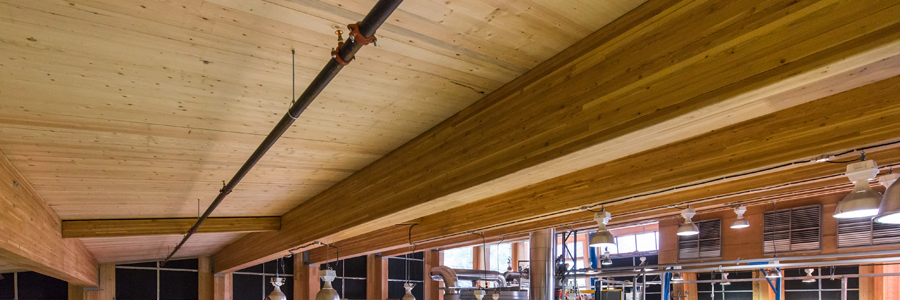What Does the Use of Cross Laminated Timber (CLT) Mean for Fire Sprinkler Systems?
I’m often asked how new construction materials may be used in conjunction with BlazeMaster® Fire Protection Systems. Today, we’ll discuss cross laminated timber (CLT), one of the most popular new products in use today for homes, multifamily and high-rise office buildings.
CLT is one type of construction material in a category generically known as mass timber. It is a wood panel product manufactured through the gluing of layers of solid-sawn lumber together. Layers are oriented perpendicularly to adjacent layers, glued on wide faces of each board (think of a stack of Jenga® blocks, with fewer levels, of course). CLT construction is in opposition to glued laminate timber, a product in which all laminations are glued in the same direction.
CLT is used in floors, walls, roofing and core construction. A relatively light building material, it offers great strength and design flexibility that allow longer spans to be created with fewer supports. It is known as a green material as it is made from renewable wood sources.
A Need for Fire Sprinkler Systems
Single-family homes built with CLT are taking advantage of the current trend toward open ceilings and finished basements. In general, these open concept homes are less “compartmentalized” than ever, offering fewer rooms in a similar footprint or square footage.
This open concept, however, may mean that a fire may spread more quickly throughout a home, with fewer walls to slow its progress. Sprinkler systems are a great, affordable solution to deal with that and should be considered for all CLT home construction.
Taller wood-framed buildings that utilize CLT as a construction material have some flexibility, as they are designed to move – expanding in the summer and contracting in the winter, offering earthquake and wind resistance. CLT has a higher density than some engineered woods such as Trus Joist®, TJI® or Paralam® PSL beams, giving it better strength and fire resistance. It is being used throughout North America in tall wood buildings, replacing steel and concrete and/or other engineered wood material.
But CLT’s BTU output in the event of a fire is much greater. The fact that it burns hotter means that a fire protection system should be part of any high-rise building design.
Other Considerations – and Questions
Fire risk in building codes is a topic that has been a subject of debate in part due to the increased use of CLT. While no specific codes have been established yet, flammability testing of CLT is ongoing. For example, testing has been completed at the National Research Council (NRC) Canada.
Here are two third-party published resources for your consideration (BlazeMaster CPVC and Lubrizol do not hold copyright to these materials, which are presented for information only):
Are wood-frame high rises a fire risk? by Robert Avsec, Firerescue1.com, 3-14-17
Fire safety of CLT and mass timber buildings by David Barber, Construction Executive, 7-13-18
To learn more about the advantages of BlazeMaster CPVC, download our Guide to CPVC Fire Sprinklers.


